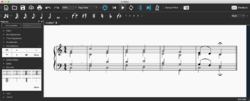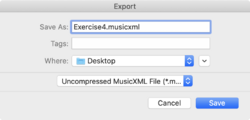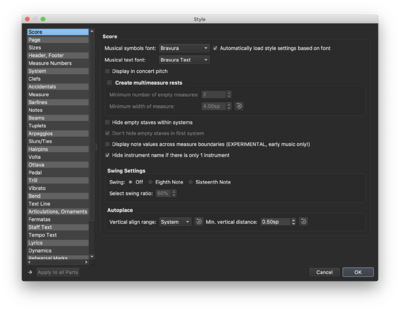MuseScore: Difference between revisions
| Line 132: | Line 132: | ||
[[File:stylefontmusescore.png|400px|thumb|center|MuseScore 3.3.4 Style format window showing Bravura selected for the music font.]] | [[File:stylefontmusescore.png|400px|thumb|center|MuseScore 3.3.4 Style format window showing Bravura selected for the music font.]] | ||
== [https://wiki.ccarh.org/wiki/Musescore_Supplement Supplement with academic examples (Christina Kim)] == | |||
Revision as of 00:24, 5 January 2022
MuseScore is a free, open-source graphical music-notation editor that is available for all three major operating systems: linux, Apple MacOS, and Microsoft Windows. These are supported by a cross-platform graphical window interface, Qt.

MuseScore's user interface is an intersection of those found in Sibelius and Finale. All three notation programs have significant overlap in their user interface conceptualization and organization. Yet there are differences in how each of these programs behaves, and this can hinders users' facility.
Finale had been under development (and under a series of management teams) since 1988, with a primary locus of development in Minnesota. Its primary strength was in the capture of real-time MIDI input. Sibelius grew out of an Acorn (UK) computer program (with no graphical display) and had until recent years a stable development environment in Cambridge. MuseScore began to take shape around 2002 in Germany as a collaborative, open-source project. It is now owned by Ultimate Guitar but for now free to use.
We present below exercises intended to help new users get started and links to specific features in the MuseScore online manual.. A more extensive set of examples with selected feature hints is available in the Musescore Supplement.
Exercises
Notes and Lyrics
This exercise introduces note entry (PDF file with step-by-step instructions).
Octaves, Slurs, Fingerings and Text
- A demonstration of how to add fingerings, slurs as well as dealing more with octave transposition during data entry on the computer keyboard (PDF file with step-by-step instructions).
Chords
- A demonstration of how to enter chords by adding notes above other notes in the chord with the shift key (PDF file with step-by-step instructions).
Voices/Layers
- A demonstration of how to place multiple voices onto a single staff (PDF file with step-by-step instructions).
Turn in

Email PDF and MusicXML files for the above exercises. To create a PDF, go to File→Export and select "PDF File" as the save type. To create a MusicXML file, go to File→Export and select "Uncompressed MusicXML File".
(PDF file with instructions for all exercises)
Choose one of the examples in the Musescore Supplement page as well.
Extra Credit: one or more additional examples from the Musescore Supplement page.
Links
- http://www.musescore.org MuseScore website.
- http://musescore.org/en/download MuseScore download page.
- https://github.com/musescore/MuseScore MuseScore source code.
- http://www.musescore.com Score sharing site for MuseScore files.
- http://www.musescore.org/en/handbook MuseScore online documentation:
- Note entry
- Palette
- Accidental
- Arpeggio
- Barline
- Beam
- Bracket
- Breath & pause
- Clef
- Cross-staff beaming
- Drum notation
- Endings
- Grace note
- Hairpin
- Key signature
- Line
- Measure rests
- Repeat
- Slur
- Tie
- Time sig.
- Tremolo
- Tuplet
- Voices
Getting started
Basics
Notation
Sound and playback
Text
Formatting
Support
Appendix
See also
Also check out the next MuseScore lab exercise where the MIDI keyboard is used to enter music.
Tips
- To use a more conventional music font, go to Format→Style...→Score pane and select "Bravura" from the dropdown menu for the Musical symbols font.




